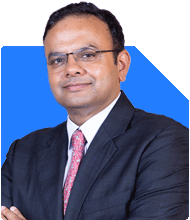Ramalingam Kalirajan |10881 Answers |Ask -Follow
Mutual Funds, Financial Planning Expert - Answered on May 07, 2024
He has an MBA in finance from the University of Madras and is a certified financial planner.
He is the director and chief financial planner at Holistic Investment, a Chennai-based firm that offers financial planning and wealth management advice.... more

Hi myself Rajib and I am 40 yrs old. I want to secure my daughter education and marriage. I want to quote nvest in Mutual Fund. Please suggest which plan is better for me for 10 yrs proposal
1. Equity Mutual Funds: Equity mutual funds have the potential to deliver higher returns over the long term compared to other asset classes. Given your investment horizon of 10 years, you may consider investing in a mix of large-cap, mid-cap, and multi-cap equity funds. These funds invest in stocks of companies across different market capitalizations, providing diversification and growth potential.
2. Balanced Advantage Funds: Balanced advantage funds, also known as dynamic asset allocation funds, dynamically manage their equity and debt allocations based on market conditions. These funds aim to provide steady returns with lower volatility compared to pure equity funds. Investing in a balanced advantage fund can offer a balanced approach to growth while managing risk.
3. Index Funds: Index funds passively track a market index such as the Nifty 50 or Sensex. They offer lower expense ratios compared to actively managed funds and can be suitable for investors seeking broad market exposure. Investing in index funds can provide diversification and potentially lower volatility over the long term.
4. Target Date Funds: Target date funds are designed to align with a specific financial goal, such as education or marriage, and automatically adjust the asset allocation over time to become more conservative as the target date approaches. These funds can simplify the investment process and provide a hands-off approach to portfolio management.
When selecting mutual funds for your investment, consider factors such as your risk tolerance, investment goals, and time horizon. It's essential to diversify your investments across multiple funds to spread risk and maximize returns over the long term.
Before making any investment decisions, I recommend consulting with a Certified Financial Planner (CFP) or financial advisor. A professional can assess your specific financial situation, goals, and risk profile and help you create a customized investment plan tailored to your needs. Regularly review your investment portfolio and make adjustments as needed to stay on track towards achieving your daughter's education and marriage goals.
You may like to see similar questions and answers below
Ramalingam Kalirajan |10881 Answers |Ask -Follow
Mutual Funds, Financial Planning Expert - Answered on May 29, 2024
Abhishek Dev | Answer |Ask -Follow
Financial Planner - Answered on Aug 05, 2023
Ramalingam Kalirajan |10881 Answers |Ask -Follow
Mutual Funds, Financial Planning Expert - Answered on May 20, 2024
Ramalingam Kalirajan |10881 Answers |Ask -Follow
Mutual Funds, Financial Planning Expert - Answered on Jul 07, 2025
Dr Dipankar Dutta |1841 Answers |Ask -Follow
Tech Careers and Skill Development Expert - Answered on Dec 14, 2025
Nayagam P P |10854 Answers |Ask -Follow
Career Counsellor - Answered on Dec 14, 2025
Radheshyam Zanwar |6744 Answers |Ask -Follow
MHT-CET, IIT-JEE, NEET-UG Expert - Answered on Dec 14, 2025
Radheshyam Zanwar |6744 Answers |Ask -Follow
MHT-CET, IIT-JEE, NEET-UG Expert - Answered on Dec 14, 2025
Dr Dipankar Dutta |1841 Answers |Ask -Follow
Tech Careers and Skill Development Expert - Answered on Dec 14, 2025
Dr Dipankar Dutta |1841 Answers |Ask -Follow
Tech Careers and Skill Development Expert - Answered on Dec 13, 2025
Dr Dipankar Dutta |1841 Answers |Ask -Follow
Tech Careers and Skill Development Expert - Answered on Dec 13, 2025
Mayank Chandel |2575 Answers |Ask -Follow
IIT-JEE, NEET-UG, SAT, CLAT, CA, CS Exam Expert - Answered on Dec 13, 2025
Radheshyam Zanwar |6744 Answers |Ask -Follow
MHT-CET, IIT-JEE, NEET-UG Expert - Answered on Dec 13, 2025
Mayank Chandel |2575 Answers |Ask -Follow
IIT-JEE, NEET-UG, SAT, CLAT, CA, CS Exam Expert - Answered on Dec 13, 2025






















